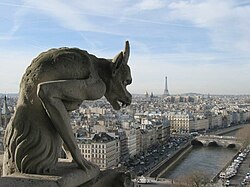No edit summary |
|||
| Line 27: | Line 27: | ||
In contemporary fiction, gargoyles are typically depicted as a (generally) winged humanoid race with demonic features: generally horns, a tail, and talons. These fictional gargoyles can generally use their wings to fly or glide, and are often depicted as having a rocky hide, or being capable of turning into stone in one way or another. |
In contemporary fiction, gargoyles are typically depicted as a (generally) winged humanoid race with demonic features: generally horns, a tail, and talons. These fictional gargoyles can generally use their wings to fly or glide, and are often depicted as having a rocky hide, or being capable of turning into stone in one way or another. |
||
===This is the ESLA Gargoyle TEAM=== |
|||
==See also== |
==See also== |
||
Revision as of 16:55, 11 May 2007

In architecture, gargoyles are the carved terminations to spouts which convey water away from the sides of buildings. The term originates from the French gargouille, originally the throat or gullet, cf. Latin gurgulio, gula, and similar words derived from root gar, to swallow, the word representing the gurgling sound of water; Ital. doccione; Ger. Ausguss, Wasserspeier.
Gargoyles are mostly eerie figures. Statues representing gargoyle-like creatures are popular sales items, particularly in goth and New Age retail stores.
A chimera, or a grotesque figure, is a similar type of sculpture that does not work as a waterspout and serves only an ornamental or artistic function. These are also popularly referred to as gargoyles.
History

The term gargoyle is most often applied to medieval work, but throughout all ages some means of throwing the water off roofs, when not conveyed in gutters, was adopted. In Egypt, gargoyles ejected the water used in the washing of the sacred vessels which seems to have been done on the flat roofs of the temples. In Greek temples, the water from roofs passed through the mouths of lions whose heads were carved or modelled in the marble or terra cotta cymatium of the cornice. At Pompeii, many terra cotta gargoyles were found that are modelled in the shape of animals.
A local legend that sprang up around the name of St. Romanus ("Romain") (631 – 641 A.D.), the former chancellor of the Merovingian king Clotaire II who was made bishop of Rouen, relates how he delivered the country around Rouen from a monster called Gargouille, having the creature captured by the only volunteer, a condemned man. The gargoyle's grotesque form was said to scare off evil spirits so they were used for protection. In commemoration of St. Romain the Archbishops of Rouen were granted the right to set a prisoner free on the day that the reliquary of the saint was carried in procession (see details at Rouen).

Although most have grotesque features, the term gargoyle has come to include all types of images. Some gargoyles were depicted as monks, combinations of real animals and people, many of which were humorous. Unusual animal mixtures, or chimeras, did not act as rainspouts and are more properly called grotesques. They serve more as ornamentation, but are now synonymous with gargoyles.
19th and 20th centuries
Gargoyles, or more precisely chimerae, were used as decoration on 19th and early 20th century buildings in cities such as New York (where the Chrysler Building's stainless steel gargoyles are celebrated), and Chicago. Gargoyles can be found on many churches and buildings.
One impressive collection of modern gargoyles can be found at Washington National Cathedral in Washington, DC. The cathedral begun in 1908 is encrusted with the limestone demons. This collection also includes Darth Vader, a crooked politician, robots and many other modern spins on the ancient tradition. The 20th Century collegiate form of the Gothic Revival produced many modern gargoyles, notably at Princeton University, Duke University and the University of Chicago.
Gargoyles in fiction
In contemporary fiction, gargoyles are typically depicted as a (generally) winged humanoid race with demonic features: generally horns, a tail, and talons. These fictional gargoyles can generally use their wings to fly or glide, and are often depicted as having a rocky hide, or being capable of turning into stone in one way or another.
This is the ESLA Gargoyle TEAM
See also
External links
Photo gallery
-
Chimera of the St. Patrick Church in Flagstaff, Arizona.
-
View of a gargoyle on the Notre Dame cathedral in Paris, France.
-
A gargoyle on the Basilica of the Sacré Cœur, Paris, France, showing the water channel.
-
A Japanese gargoyle adorning Himeji Castle.
-
Gargoyle at Fontevraud's Abbey, Fontevraud, France.Gargoyle at Fontevraud's Abbey, Fontevraud, France.



